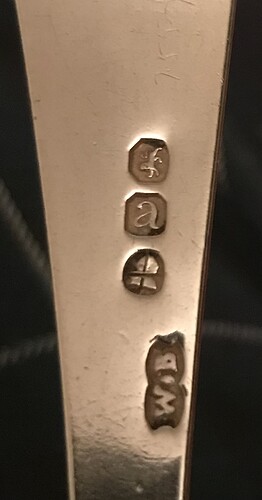Let’s face it 1814 was not a great year for Farmer George. If the 1812 war was the final gasp of the Brits trying to get their American empire back, the signing of the Treaty of Peace and Amity in December at Ghent ended that idea. For ever.
Meanwhile, Hester’s grandson and now owner of her eponymous silver hustle, William Bateman I, was busy making things like this old English style sauce ladle and shipping it off to the Channel Islands to avoid the 6d in the pound duty on silver to pay for the wars against the French who had backed the Americans against the English mostly so annoying printer and publicist Ben Franklin would leave King Louis alone to enjoy his last days in a palace so large he needed three in-house mistresses at a time.
But take a look at George. Someone’s crossed him out. It’s a stamp not a cut and it’s deliberate and precise not haphazard.
It’s also not the way you clawed back duty paid at time of assay. That required a draw back stamp of an etiolated image of a lady doing something uncomfortable to herself with a shield.
William’s hustle was silver sent to the Channel Islands where it was only charged at 2d so there was a 4d saving per troy oz. The drawback mark was stamped at the exit port upon departure.
So who crossed out George and why? My theory is this went not to the CI but directly to the Excited State of America, specifically New York where, since the Battle of New Orleans fought to allow General Jackson to “win” the war of 1812 two weeks after the Treaty of Ghent had ended it hadn’t yet happened, the New York retailer decided on a little personal regicide.
But it’s just a theory. David MacKinley has written and posted illuminative polemics on silver duty and its drawbacks literal and figurative. But David doesn’t deal with crossed out kings.

